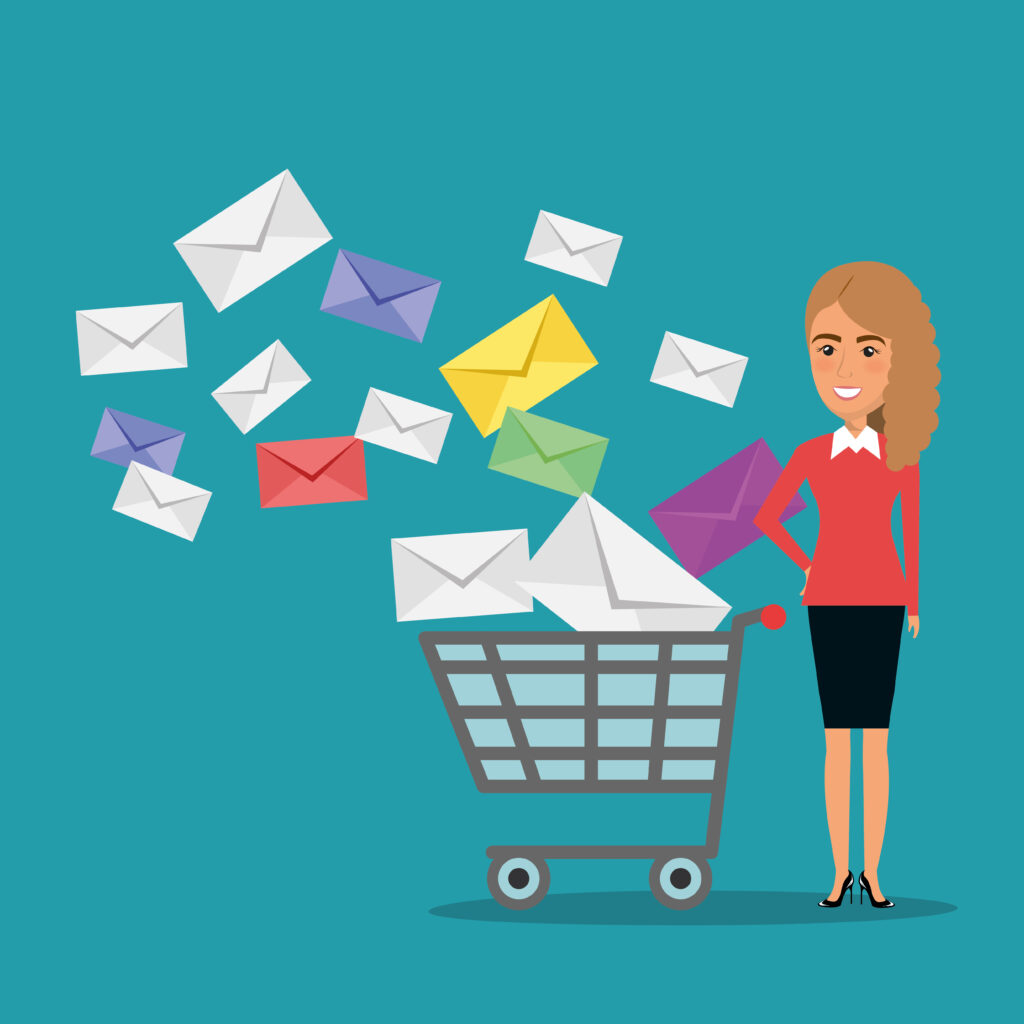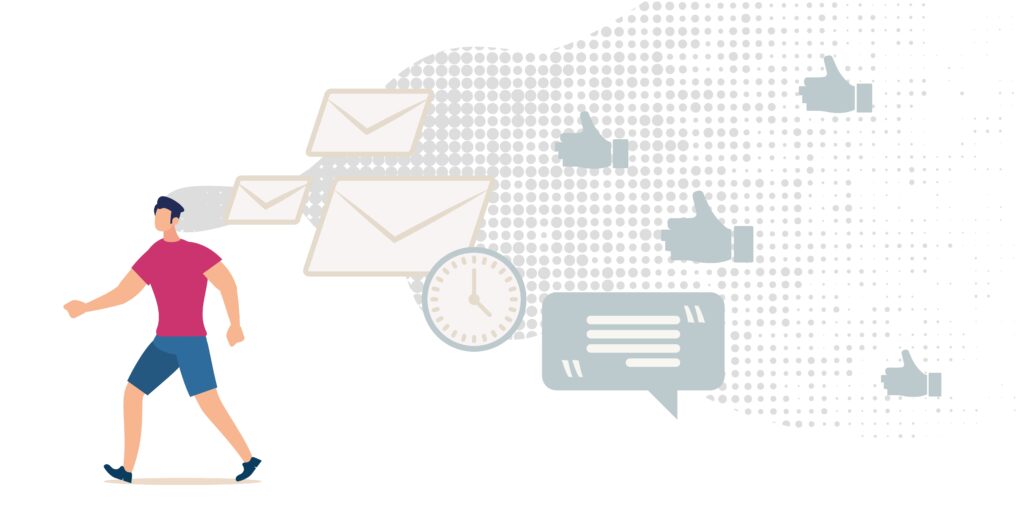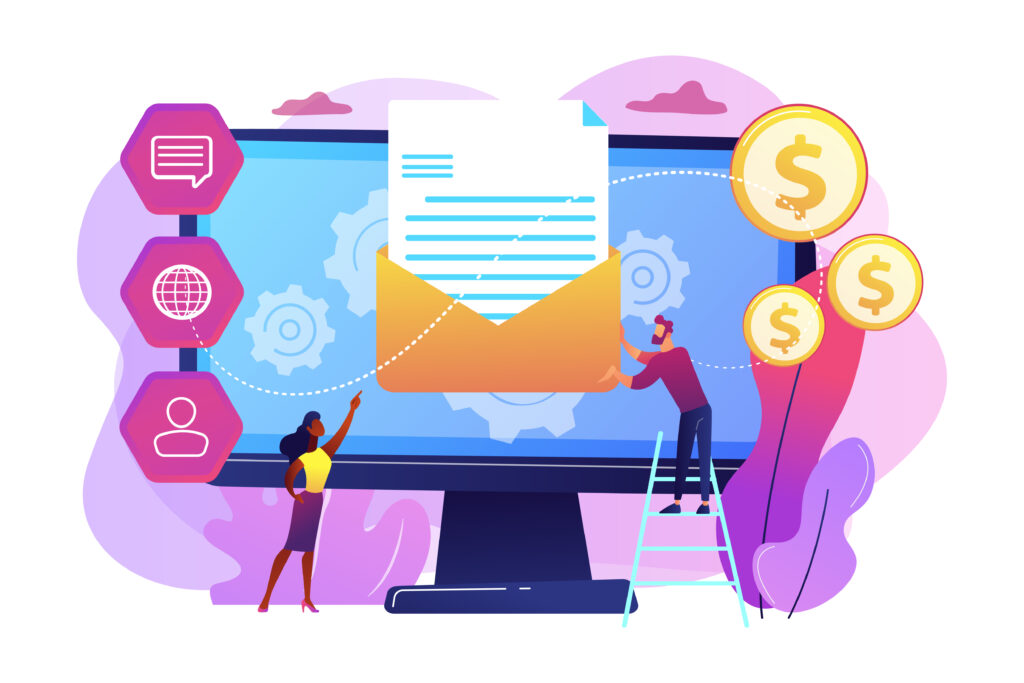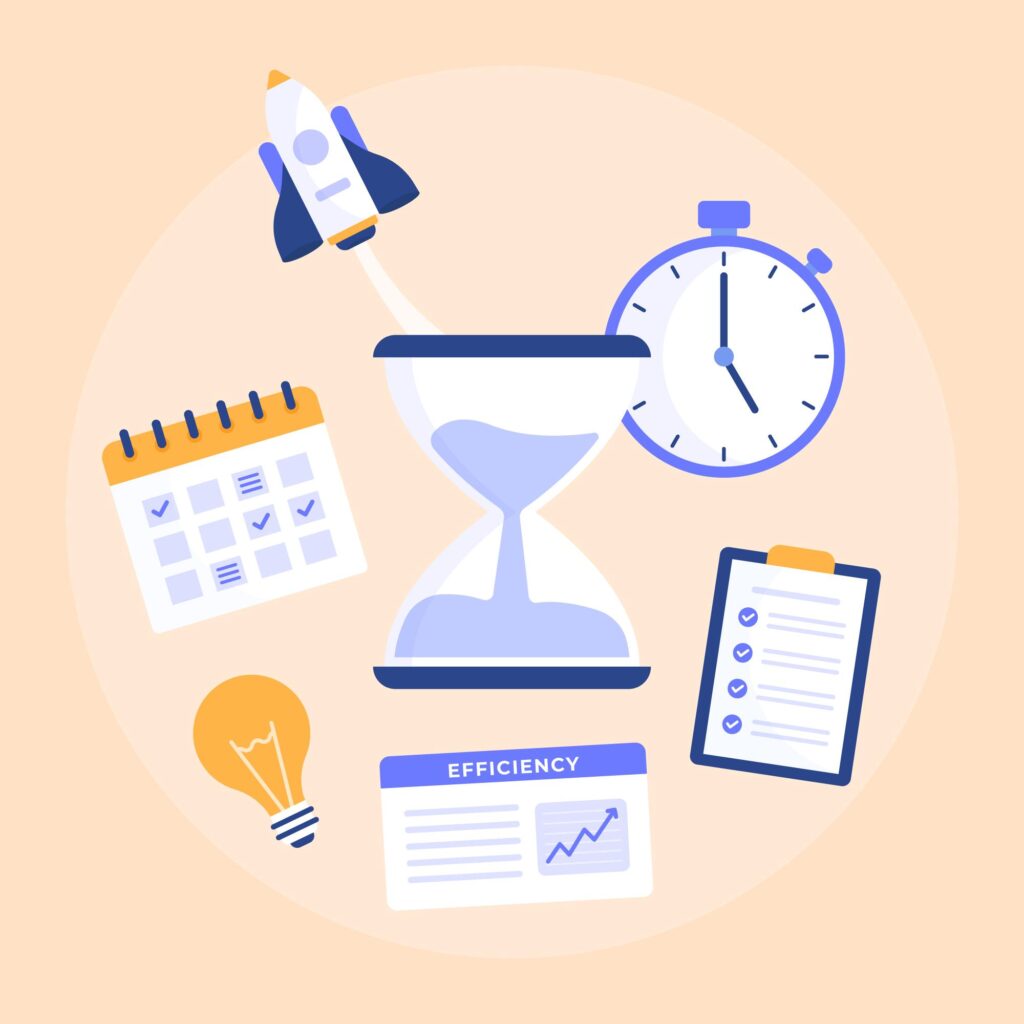
Key Takeaways
- Email marketing automation for eCommerce saves time and delivers personalized emails to customers based on their actions, enhancing the shopping experience.
- Email marketing automation improves communication, increases engagement and conversions.
- Segmentation, automated workflows, CRM integration, and monitoring key metrics are essential for effective email automation.
- eCommerce email flows include welcome series, abandoned cart recovery, post-purchase follow-up & more.
- Setting goals , designing the workflow, crafting content, optimization and integrating with CRM and other tools are crucial for successful email automation.
- Upselling and cross-selling campaigns, re-engagement campaigns, customer loyalty campaigns, are effective strategies for eCommerce businesses.
Welcome to the exciting world of email marketing automation for eCommerce!
In the current digital world, email automation has become a game-changer, enabling online businesses to communicate with clients in a personalized and meaningful way.
By leveraging proven practices and real-life examples, you’ll discover how to supercharge your eCommerce success through automated email campaigns.
In this comprehensive guide, we’ll delve into the best practices of email marketing automation tailored explicitly for eCommerce.
From segmenting your audience, crafting compelling content, and designing effective workflows, you’ll gain valuable insights and practical strategies to elevate your email marketing game.
Get ready to unlock the potential of email automation and witness the transformative power it can have on your eCommerce business.
- What do you mean by email marketing automation for eCommerce?
- Why email marketing automation for eCommerce is important?
- Email automation best practices
- Types of eCommerce email flows
- Creating effective email automation workflows
- Examples of marketing automation campaigns in eCommerce
- Measuring and optimizing email automation workflows
What do you mean by email marketing automation for eCommerce?

Email marketing automation for eCommerce is like having a smart assistant who helps online stores send the right emails to customers at the right time.
It’s all about using clever software and pre-set rules to automatically send personalized emails based on what customers do or don’t do.
For example, if someone adds products to their shopping cart but leaves without buying.
Then, the automation system can send them a friendly email reminder with a special offer to encourage them to return and complete their purchase.
Think of it as having a virtual helper that saves time and ensures each customer gets the most relevant and helpful emails.
By using email marketing automation, online stores can build better customer relationships, recover lost sales, and make the shopping experience more personalized or enjoyable.
It’s like having a personal shopping assistant who knows exactly what you want and sends you the perfect emails at the right moment.
Why email marketing automation for eCommerce is important?

Email marketing automation for eCommerce is essential for online businesses. Here’s why:
1. Efficient and personalized communication
Saving time and effort, email automation enables eCommerce enterprises to engage with their customers in a more effective and personalized way.
By leveraging workflow automation and predefined triggers, businesses can send targeted emails based on customer actions, preferences, or specific stages in their journey. Expert Java development services can optimize these workflows, making them even more efficient and personalized.
Customers will receive pertinent information, product suggestions, and marketing offers that are catered to their unique requirements and interests as a result.
2. Increased engagement and conversions
Automation enables businesses to create well-designed email flows that guide customers through buying.
By sending timely and relevant emails, such as abandoned cart reminders, post-purchase follow-ups, or personalized product recommendations.
Businesses can engage customers at crucial touchpoints and increase the chances of conversion.
This leads to higher click-through rates, improved customer engagement, and increased sales.
3. Enhanced customer experience and loyalty
Using email automation best practices, such as segmentation and personalization, eCommerce businesses can provide customers with a more enjoyable and personalized experience.
Thanks to automated workflows, businesses can provide the appropriate content to the correct individuals at the proper time, considering their requirements and preferences.
This fosters customer satisfaction, strengthens brand loyalty, and encourages repeat purchases.
4. Time and resource optimization
Email automation workflows automate repetitive tasks, freeing up valuable time and resources for eCommerce businesses.
Instead of manually sending individual emails, automated mass email services allow businesses to create email flows that can be triggered automatically based on customer behavior or predefined schedules.
This enables businesses to efficiently scale their email marketing efforts, reach a larger audience, and achieve better results without exhausting human resources.
5. Data-driven insights and optimization
Email automation workflows provide valuable data and insights into customer behavior, preferences, and the effectiveness of different campaigns.
By analyzing key metrics like open rates, click-through rates, and conversions, businesses can identify areas for improvement and optimize their email marketing strategies accordingly.
This iterative approach, supported by data-driven insights, allows businesses to continually refine their automated email workflows for better performance and increased ROI.
Email automation best practices

Email automation best practices play a crucial role in maximizing the effectiveness of email marketing for eCommerce.
Let’s explore them in more detail and add a few additional points:
1. Segmenting your email list
Divide your subscribers into specific groups or segments based on various factors such as demographics, preferences, purchase history, engagement levels, or lifecycle stage.
This segmentation allows you to send targeted and personalized emails to each group, tailoring the content to their needs and interests.
It improves relevance, engagement, and, ultimately, conversion rates.
2. Personalization and dynamic content
Take advantage of email automation capabilities to personalize your emails.
Incorporate dynamic content that adapts based on recipient information, such as their name, past purchases, or browsing behavior.
This level of personalization helps create a more individualized experience for customers, increasing their engagement and fostering a sense of connection with your brand.
3. Timing and frequency
Find the optimal timing for email sending by analyzing customer behavior and preferences.
Experiment with different send times and track metrics like open rates and click-through rates to determine when your audience is most receptive.
Additionally, avoid bombarding subscribers with excessive emails. Strike a balance between staying top of mind and not overwhelming them with frequent messages.
Respect their inbox and deliver content that provides value.
4. Automated email workflows
Develop a well-structured email automation workflow that maps out the customer journey and engages customers at different stages.
This includes welcome series, abandoned cart recovery, post-purchase follow-ups, and re-engagement campaigns.
By setting up automated workflows, you can nurture leads, guide customers through their purchase journey, and foster long-term relationships, all while saving time and effort.
5. Test and optimize
Implement A/B testing to experiment with different elements of your emails, such as subject lines, CTAs, visuals, or email layouts.
Monitor the performance of different variations and identify the best-performing elements.
Optimize your email automation workflows based on data-driven insights to improve engagement, conversions, and overall campaign effectiveness.
6. Visualize email flows with a flow chart
Create a visual representation of your email flows using an email marketing flow chart.
This provides a clear overview of the sequence and timing of emails in your automation workflows.
It helps you visualize the customer journey, identify gaps or redundancies, and ensure a smooth and cohesive email experience for your customers.
7. CRM integration and automation
Integrate your email marketing automation platform with your customer relationship management (CRM) system.
This enables seamless data synchronization, allowing you to leverage customer data for segmentation, personalization, and more targeted campaigns.
CRM automation examples include automatically updating customer profiles, triggering emails based on specific CRM events (e.g., new lead, customer milestone), and automating follow-up tasks based on customer interactions.
8. Monitor and analyze key metrics
Regularly track and analyze key email marketing metrics such as open rates, click-through rates, conversion rates, revenue per email, and customer lifetime value.
Use these insights to measure the effectiveness of your email automation workflows, identify areas for improvement, and make data-driven decisions to optimize your campaigns.
Types of eCommerce email flows

Email automation for eCommerce involves implementing various types of email flows to optimize customer engagement and drive conversions.
Let’s delve into these email flows in more detail and add a few additional points:
A. Welcome series
The welcome series is a sequence of emails designed to make a positive first impression on new subscribers.
It helps introduce your brand, establish a connection, and set expectations for future communication.
Components of a welcome series can include:
- Welcome email: Express gratitude, provide a warm introduction, and set expectations for the subscriber’s inbox experience.
- Product highlights: Showcase popular products or categories to pique interest and encourage exploration.
B. Abandoned cart recovery
Cart abandonment is a common challenge for eCommerce businesses.
Automated email workflows can help recover lost sales by reminding customers to complete their purchase and addressing any concerns or barriers they may have.
Strategies for abandoned cart recovery emails include:
- Timely reminders: Send a series of emails reminding customers about their abandoned carts and offering incentives like discounts, free shipping, or limited-time offers.
- Customer support: Provide assistance by addressing common questions, offering live chat support, or providing alternative product suggestions.
- Urgency and scarcity: Create a sense of urgency by highlighting limited stock availability or time-limited offers to encourage immediate action.
C. Post-purchase follow-up
After a customer completes a purchase, post-purchase follow-up emails play a vital role in building customer loyalty and encouraging repeat business.
Key elements of post-purchase follow-up emails can include:
- Order confirmation: Send a confirmation email with details of the purchase, including shipping information and customer support contact.
- Cross-selling opportunities: Suggest complementary products or accessories based on the customer’s purchase history to drive additional sales.
D. Product recommendations
Leverage customer data and automation workflows to provide personalized product recommendations, enhancing the customer experience and driving upsells.
Implementation of product recommendation emails involves:
- Analyzing customer behavior: Use browsing history, purchase patterns, and customer preferences to determine relevant product recommendations.
- Dynamic content: Insert personalized product recommendations within emails, showcasing items that align with the customer’s interests or past purchases.
- Upsell opportunities: Highlight higher-value or upgraded products that complement the customer’s previous purchases, encouraging them to explore additional options.
E. Re-engagement campaigns
Re-engage inactive subscribers who haven’t interacted with your emails for a while. Send targeted emails with exclusive offers, personalized content, or incentives to bring them back into the fold.
F. Event-based emails
Utilize automation workflows to send emails on special occasions like birthdays, anniversaries, or milestones. Provide personalized offers, discounts, or exclusive content to celebrate and engage with your customers.
G. Customer feedback and surveys
Send automated emails to gather customer feedback, conduct surveys, or solicit reviews. Use this valuable information to improve your products, services, and overall customer experience.
By incorporating these email automation best practices and implementing a well-designed email flow, eCommerce businesses can create meaningful customer interactions, drive conversions, and foster long-term customer loyalty.
Creating effective email automation workflows

Creating effective email automation workflows is crucial for successful eCommerce email marketing.
A. Setting goals and objectives
1. Define desired outcomes
Clearly establish your goals for email automation, such as increasing sales, improving customer engagement, or boosting brand loyalty. Align these goals with your overall marketing objectives.
2. Align goals with customer journey stages
Identify the different stages of the customer journey, from awareness to conversion and retention.
Determine how email automation can support and guide customers at each stage, providing relevant content and offers.
B. Designing the workflow
1. Map the customer journey
Visualize the customer’s interactions with your brand at various touchpoints.
Consider the different stages, including initial contact, consideration, purchase, and post-purchase.
2. Determine triggers and actions
Identify the events or actions that will trigger automated emails.
For example, a new subscriber might trigger a welcome email, while an abandoned cart triggers a cart recovery email.
Define the specific actions and emails to be sent at each stage to guide customers effectively.
C. Crafting compelling email content
1. Writing engaging subject lines and email copy
Grab the attention of recipients with captivating subject lines that entice them to open your emails.
Craft informative, relevant, and persuasive email content that addresses customer pain points, offers solutions, and showcases the value of your products or services.
2. Incorporating strong call-to-action (CTA) elements
Clearly communicate the desired action you want subscribers to take in your emails.
Use persuasive language and create a sense of urgency when appropriate.
Make it easy for recipients to complete the desired action, such as making a purchase, signing up for an event, or leaving a review.
D. Personalization and segmentation
1. Utilize customer data
Leverage the data you have about your customers to personalize your emails.
Use information such as purchase history, browsing behavior, and demographics to tailor the content and offers to each recipient.
2. Segment your email list
Divide your subscribers into specific groups based on criteria like demographics, interests, or past purchase behavior.
This allows you to send targeted emails that resonate with each segment, increasing engagement and conversion rates.
Using an email list cleaning tool can also ensure each segment remains accurate and up to date by removing invalid or outdated contacts.
E. Testing and optimization
1. Conduct A/B testing
Experiment with different elements of your email automation workflows, such as subject lines, CTAs, visuals, or email layouts.
Test different variations and track the performance metrics to identify the most effective elements.
2. Continuously optimize
Use data-driven insights to make improvements to your email automation workflows.
Analyze key metrics like open rates, click-through rates, and conversions to identify areas for optimization and make adjustments accordingly.
F. Integrating with CRM and other tools
1. CRM automation examples
Integrate your email marketing automation with your customer relationship management (CRM) system to streamline data synchronization, automate customer updates, and trigger personalized emails based on CRM events or milestones.
2. Email marketing flow chart
Create a visual representation of your email flows using an email marketing flow chart.
This helps you visualize the sequence, timing, and content of your automated emails, ensuring a smooth and cohesive customer experience.
Examples of marketing automation campaigns in eCommerce

A. Upselling and cross-selling campaigns
1. Upselling campaigns
Send automated emails to customers who have made a purchase, recommending higher-value or upgraded products that complement their previous purchases.
Highlight the benefits and features of these products to encourage customers to make additional purchases.
2. Cross-selling campaigns
Utilize automation workflows to suggest complementary products or accessories based on the customer’s purchase history.
For example, if a customer buys a camera, you can send them emails recommending lenses, camera bags, or tripods.
B. Re-engagement campaigns
1. Target inactive subscribers
Identify subscribers who haven’t engaged with your emails for a certain period. Send automated emails with exclusive offers, discounts, or personalized content to re-engage them. Encourage them to revisit your website, make a purchase, or update their preferences.
2. Win-back campaigns
If a customer hasn’t made a purchase in a while, send a series of automated emails offering incentives, such as discounts, free shipping, or loyalty program rewards, to entice them back. Showcase new products or highlight any improvements or updates to your offerings.
C. Customer loyalty campaigns
1. Reward programs
Implement automated email workflows to communicate with loyal customers and keep them engaged. Send personalized emails notifying them of their rewards status, points earned, or upcoming special offers.
2. Exclusive promotions
Segment your email list to target loyal customers specifically. Send them exclusive promotions, early access to sales, or sneak peeks of new products. Make them feel valued and appreciated for their continued support.
D. Product replenishment campaigns
1. Automated reminders
For consumable or regularly used products, send automated emails to remind customers to replenish their supplies. This could include items like skincare products, pet food, or office supplies.
2. Personalized recommendations
Use customer purchase history and browsing behavior to suggest specific products that are likely to require replenishment. Offer convenience by allowing customers to reorder with just a few clicks.
E. Birthday or anniversary campaigns:
1. Personalized greetings
Set up automated emails to wish customers a happy birthday or celebrate their anniversary as a customer. Include personalized offers, discounts, or gifts to make the occasion special and encourage them to make a purchase.
2. Milestone rewards
Acknowledge and celebrate customer milestones, such as reaching a certain number of purchases or loyalty program points. Send automated emails with exclusive rewards, discounts, or personalized thank-you messages.
F. Post-purchase nurturing campaigns
1. Educational content
Provide value to customers post-purchase by sending automated emails with educational content related to their purchase. This could include how-to guides, tips and tricks, or usage ideas that enhance their experience with the product.
2. Customer support and satisfaction
Follow up with customers after their purchase to ensure satisfaction and address any concerns. Send automated emails offering assistance, providing contact information for customer support, and encouraging feedback or reviews.
G. Seasonal or holiday campaigns
1. Holiday promotions
Use automated email workflows to deliver targeted promotions and offers during specific holidays or seasons. Customize emails with festive themes, exclusive discounts, or limited-time offers to create a sense of urgency.
2. Gift guides
Create automated emails featuring curated gift ideas for different occasions or recipient profiles. Help customers find the perfect gifts and make their shopping experience easier and more enjoyable.
Measuring and optimizing email automation workflows

A. Key performance indicators (KPIs) for email marketing automation:
To gauge the success of your email automation efforts in eCommerce, it’s crucial to monitor and analyze key performance indicators. Some relevant KPIs include:
Open rates
Measure the percentage of recipients who open your emails. This indicates the effectiveness of your subject lines and overall email appeal.
Click-through rates
Evaluate the percentage of recipients who click on links or CTAs within your emails. This demonstrates the engagement and interest generated by your content.
Conversion rates
Track the percentage of recipients who complete the desired action, such as making a purchase, subscribing, or downloading. This metric directly reflects the effectiveness of your email automation in driving conversions.
Revenue per email
Calculate the revenue generated from each email campaign to assess its impact on your eCommerce business’s bottom line.
Customer lifetime value
Determine the average value a customer contributes to your business over their lifetime. This metric helps assess the long-term profitability and success of your email automation workflows.
B. A/B testing and experimentation:
To optimize your email campaigns and continuously improve your automation workflows, leverage A/B testing and experimentation:
Conduct A/B tests
Test different elements of your emails, such as subject lines, CTAs, email layouts, visuals, and send times. Split your subscriber base into two groups and send each group a variation of the email. Compare the performance metrics to identify the most effective elements.
Analyze test results
Evaluate the data collected from A/B tests to determine which variations yielded better results. Identify patterns, insights, and best practices that can be applied to future email automation campaigns.
Iterate and refine
Implement the winning elements and insights derived from A/B testing into your email automation workflows. Continuously refine and optimize your strategies based on data-driven insights, aiming for higher engagement, conversion rates, and overall effectiveness.
Monitor customer feedback
Pay attention to customer responses, feedback, and behavior to gain further insights into the effectiveness of your email automation. Leverage customer surveys, feedback forms, and social media marketing interactions to gather valuable information for refining your workflows.
Stay updated with industry trends
Keep an eye on the latest trends and best practices in email marketing automation for eCommerce. Stay abreast of new technologies, tools, and strategies that can enhance your workflows and deliver better results.
By measuring key performance indicators, conducting A/B tests, and embracing a culture of experimentation, eCommerce businesses can continually optimize their email automation workflows, ensuring they deliver compelling content, engage their audience, and drive desired outcomes.
Conclusion
In the fast-paced world of eCommerce, staying ahead requires smart strategies and innovative approaches.
Email marketing automation is your secret weapon, allowing you to engage customers at every stage of their journey with personalized messages and timely offers.
By implementing the best practices and examples, you’ll create a powerful email automation workflow that drives conversions, fosters customer loyalty, and propels your eCommerce business to new heights.
So, embrace the possibilities, put your newfound knowledge into action, and get ready to witness the remarkable impact of email marketing automation on your eCommerce success story.
